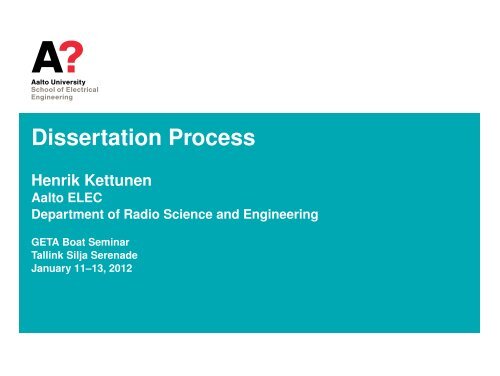Dissertation Process - GETA
Dissertation Process - GETA
Dissertation Process - GETA
Create successful ePaper yourself
Turn your PDF publications into a flip-book with our unique Google optimized e-Paper software.
<strong>Dissertation</strong> <strong>Process</strong><br />
Henrik Kettunen<br />
Aalto ELEC<br />
Department of Radio Science and Engineering<br />
<strong>GETA</strong> Boat Seminar<br />
Tallink Silja Serenade<br />
January 11–13, 2012
Contents<br />
▶ Earning the degree<br />
▶ <strong>Dissertation</strong> procedure<br />
▶ My thesis<br />
▶ My defence<br />
Warning! This presentation is mostly based on my own recollection<br />
and the guidelines of Aalto ELEC. Check the details from your own<br />
university!<br />
<strong>Dissertation</strong> <strong>Process</strong><br />
<strong>GETA</strong> Boat Seminar, January 11–13, 2012<br />
2 / 17
Earning a doctoral degree<br />
”Government Decree on University Degrees Section 22, (1) and (3):<br />
To earn a degree of Doctor of Science, the student must:<br />
1. complete the required postgraduate studies,<br />
2. demonstrate independent and critical thinking in relation to their field of<br />
research,<br />
3. write a doctoral dissertation and defend it in public.<br />
An approved doctoral dissertation may also be a monograph or a number of<br />
scientific publications or manuscripts vetted for publication deemed<br />
sufficient by the university, which deal with the same set of problems and a<br />
paper summarising the findings or some other work which meets<br />
corresponding scientific criteria. Publications may also include co-authored<br />
publications if the author’s independent contribution to them can be<br />
demonstrated.”<br />
<strong>Dissertation</strong> <strong>Process</strong><br />
<strong>GETA</strong> Boat Seminar, January 11–13, 2012<br />
3 / 17
The dissertation procedure in short<br />
1. Collect the credit points<br />
2. Do the research<br />
3. Publish the results<br />
4. Write the thesis manuscript (a monograph or a summary of the<br />
articles)<br />
5. Apply for permission to publish (The appoinment of preliminary<br />
examiners)<br />
6. Reply the examiners’ comments and make the required revisions<br />
7. Apply for the opponent<br />
8. Print the book<br />
9. Defend your thesis in public examination<br />
10. Apply for the evaluation of the thesis and the doctoral certificate<br />
11. Graduate<br />
<strong>Dissertation</strong> <strong>Process</strong><br />
<strong>GETA</strong> Boat Seminar, January 11–13, 2012<br />
4 / 17
The dissertation procedure in short<br />
▶ Check the details from your own university!<br />
▶ In Aalto ELEC all applications go through the Doctoral<br />
Programme Committee<br />
▶ Information for Aalto ELEC doctoral students:<br />
https://into.aalto.fi/display/endoctoralelec/Homepage<br />
<strong>Dissertation</strong> <strong>Process</strong><br />
<strong>GETA</strong> Boat Seminar, January 11–13, 2012<br />
5 / 17
Preliminary examination<br />
▶ When your supervisor is happy with your manuscript, it can be<br />
sent to pre-examination.<br />
▶ (Before that, a language check is recommended.)<br />
▶ ”The supervisor is responsible for finding suitable preliminary<br />
examiners with expertise on the topic of the dissertation; they<br />
must actively publish in the field of the dissertation. They cannot<br />
work in a close relationship with the doctoral dissertation writer,<br />
supervisor or instructor to avoid partiality concerns (as regards<br />
partiality, the rules pertinent to opponents apply).”<br />
▶ The examiners have 8 weeks to give their statement (In my<br />
case, due to the summer holidays, the time was extended to<br />
10(?) weeks)<br />
<strong>Dissertation</strong> <strong>Process</strong><br />
<strong>GETA</strong> Boat Seminar, January 11–13, 2012<br />
6 / 17
My thesis<br />
Complex Electromagnetic Responses from Simple Geometries<br />
▶ Supervisor<br />
Department of Radio Science and Engineering<br />
▶<br />
Prof. Ari Sihvola<br />
▶ Instructor<br />
▶ Dr. Henrik Wallén<br />
How to solve the polarizability of a<br />
hemisphere? What are surface plasmons, or<br />
electrostatic resonances? Can a composite<br />
slab be modeled as an effectively<br />
homogeneous medium? How are its<br />
effective material parameters then<br />
retrieved, and what are the limitations of<br />
this homogenization procedure? We find out<br />
that even simple geometries can sometimes<br />
behave in a complex way.<br />
▶ Pre-examiners<br />
▶ Prof. Christian Brosseau, Brest, France<br />
▶ Prof. Daniel Sjöberg, Lund, Sweden<br />
▶ Opponent<br />
▶<br />
Prof. Andrea Alù, Austin, Texas, USA<br />
9HSTFMG*aeddge+<br />
ISBN 978-952-60-4337-1 (pdf)<br />
ISBN 978-952-60-4336-4<br />
ISSN-L 1799-4934<br />
ISSN 1799-4942 (pdf)<br />
ISSN 1799-4934<br />
Aalto University<br />
School of Electrical Engineering<br />
Department of Radio Science and Engineering<br />
www.aalto.fi<br />
BUSINESS +<br />
ECONOMY<br />
ART +<br />
DESIGN +<br />
ARCHITECTURE<br />
SCIENCE +<br />
TECHNOLOGY<br />
CROSSOVER<br />
DOCTORAL<br />
DISSERTATIONS<br />
Aalto-DD 106/2011<br />
Henrik Kettunen Complex electromagnetic responses from simple geometries Aalto University<br />
Complex<br />
electromagnetic<br />
responses from<br />
simple geometries<br />
Henrik Kettunen<br />
DOCTORAL<br />
DISSERTATIONS<br />
<strong>Dissertation</strong> <strong>Process</strong><br />
<strong>GETA</strong> Boat Seminar, January 11–13, 2012<br />
7 / 17
Publications included in my thesis<br />
1. H. Kettunen, H. Wallén and A. Sihvola, “Polarizability of a dielectric hemisphere,” Journal<br />
of Applied Physics, vol. 102, no. 4, 044105, 2007.<br />
2. H. Kettunen, H. Wallén and A. Sihvola, “Electrostatic resonances of a<br />
negative-permittivity hemisphere,” Journal of Applied Physics, vol. 103, no. 9, 094112,<br />
2008.<br />
3. H. Kettunen, H. Wallén and A. Sihvola, “Electrostatic response of a half-disk,” Journal of<br />
Electrostatics, vol. 67, no. 6, pp. 890–897, 2009.<br />
4. H. Wallén, H. Kettunen and A. Sihvola, “Surface modes of negative-parameter interfaces<br />
and the importance of rounding sharp corners,” Metamaterials, vol. 2, no. 2–3,<br />
pp. 113–121, 2008.<br />
5. H. Kettunen, J. Qi, H. Wallén and A. Sihvola, “Homogenization of thin dielectric<br />
composite slabs: techniques and limitations,” Applied Computational Electromagnetics<br />
Society Journal, vol. 26, no. 3, pp. 179–187, 2011.<br />
6. J. Qi, H. Kettunen, J. Qi, H. Wallén and A. Sihvola, “Quasi-dynamic homogenization of<br />
geometrically simple dielectric composites,” Applied Computational Electromagnetics<br />
Society Journal, vol. 25, no. 12, pp. 1036–1045, 2010.<br />
(Altogether I have contributed in 13 journal papers and 21 conference papers)<br />
<strong>Dissertation</strong> <strong>Process</strong><br />
<strong>GETA</strong> Boat Seminar, January 11–13, 2012<br />
8 / 17
Printing the book<br />
▶ I ordered 60 copies<br />
▶ The university took 30 of them<br />
▶ 15 of those were distributed in the defence<br />
▶ I’m left with 6 copies<br />
▶ Also an electronic version is available at<br />
http://lib.tkk.fi/Diss/2011/isbn9789526043371/<br />
Your university/department may or may not participate in the printing<br />
costs, so be sure to check the price beforehand!<br />
<strong>Dissertation</strong> <strong>Process</strong><br />
<strong>GETA</strong> Boat Seminar, January 11–13, 2012<br />
9 / 17
The press release<br />
Sähkötekniikan korkeakoulu<br />
http://elec.aalto.fi/<br />
p. 09-47001/Katrina Nykänen<br />
Väitöstiedote 22.11.2011<br />
Muodoltaan yksinkertainen voi olla sähköisesti<br />
monimutkainen<br />
Väitöskirjan nimi<br />
Väitöskirjan sisältö<br />
Complex electromagnetic responses from simple geometries<br />
Yksinkertaisten geometrioiden synnyttämät monimutkaiset sähkömagneettiset<br />
vasteet<br />
Jokainen väliaine tai materiaali kätkee sisälleen paljaalle silmälle näkymättömän<br />
mikrotason hienorakenteen – viime kädessä alkuaineetkin rakentuvat omista<br />
atomeistaan. Aineen sisäisten rakenneosien ja ulkoisten sähkö- ja<br />
magneettikenttien monimutkaisen vuorovaikutuksen seurauksena määräytyvät<br />
aineen havaittavat sähkömagneettiset ominaisuudet, joita usein voidaan kuvata<br />
yksinkertaisilla makroskooppisilla parametreilla. Väitöskirjan tavoite on syventää<br />
ymmärrystä materiaalien sähkömagneettisesta mallinnuksesta. Tulee siis pystyä<br />
määrittämään aineen sisäisten rakenneosasten vaste, joka määräytyy pitkälti<br />
näiden pienten rakennuspalikoiden muodosta.<br />
Väitöskirjassa mallinnetaan erityisesti puolipallon muotoista kappaletta.<br />
Erikoistapauksena tutkitaan tilannetta, jossa kappaleen sähköinen permittiivisyys on<br />
negatiivinen ympäristöönsä nähden. Tällöin kappaleen pinnalle voi herätä hyvin<br />
voimakkaita kenttämuotoja, ns. pintaplasmoneja. Erityisesti terävien nurkkien<br />
havaitaan aiheuttavan hyvin voimakkaita vasteita.<br />
Viime aikoina suurta kiinnostusta ovat herättäneet täysin keinotekoiset aineet, ns.<br />
metamateriaalit, joille pyritään luomaan ominaisuuksia, joita ei luonnossa sinällään<br />
esiinny. Väitöskirja perehtyy keinotekoisten materiaalien luomisen edellytyksiin ns.<br />
homogenisointimenetelmien kautta ja etsii rajoituksia aineen rakennuspalikoiden, eli<br />
ns. yksikkökoppien, vähimmäismäärälle ja maksimikoolle.<br />
Väitöskirjan ala<br />
Väittelijä<br />
Sähkömagnetiikka<br />
Henrik Kettunen, TkL<br />
Syntynyt Orimattilassa 1980<br />
Ylioppilaaksi Pirkkalan yhteislukiosta 1999<br />
Väitöksen ajankohta 15.12.2011 klo 12<br />
Paikka<br />
Vastaväittäjä<br />
Valvoja<br />
Aalto-yliopiston sähkötekniikan korkeakoulu, Sali S5, Otakaari 5L, Espoo<br />
professori Andrea Alù, The University of Texas at Austin, USA<br />
professori Ari Sihvola, Aalto-yliopiston sähkötekniikan korkeakoulu,<br />
radiotieteen ja -tekniikan laitos<br />
Väitöskirjan verkko-osoite<br />
http://lib.tkk.fi/Diss/2011/isbn9789526043371/<br />
Väittelijän yhteystiedot<br />
Henrik Kettunen, p. 09 470 22262, henrik.kettunen@aalto.fi<br />
Aalto-yliopiston sähkötekniikan korkeakoulu,<br />
radiotieteen ja -tekniikan laitos, PL 13000, 00076 AALTO<br />
Väitöskirja on julkisesti nähtävillä Aalto-yliopiston sähkötekniikan korkeakoulun kirjaston ilmoitustaululla<br />
(Otakaari 5 A).<br />
<strong>Dissertation</strong> <strong>Process</strong><br />
<strong>GETA</strong> Boat Seminar, January 11–13, 2012<br />
10 / 17
The defence<br />
Mine took place on December 15, 2011<br />
”The public examination<br />
is an event where a doctoral student or candidate defends<br />
the scientific findings presented in his/her dissertation.<br />
In the event, the opponent presents questions, to which<br />
the candidate responds. The opponent is usually holds<br />
a doctorate or professorship in the field of the dissertation,<br />
and the public examination is supervised by the custos,<br />
usually the professor who has supervised the thesis work.”<br />
Don’t forget the protocol!<br />
Photo: Sami Ilvonen<br />
<strong>Dissertation</strong> <strong>Process</strong><br />
<strong>GETA</strong> Boat Seminar, January 11–13, 2012<br />
11 / 17
Lectio praecursoria<br />
Photo: Henrik Wallén<br />
<strong>Dissertation</strong> <strong>Process</strong><br />
<strong>GETA</strong> Boat Seminar, January 11–13, 2012<br />
12 / 17
Public examination of the thesis<br />
Photo: Sami Ilvonen<br />
<strong>Dissertation</strong> <strong>Process</strong><br />
<strong>GETA</strong> Boat Seminar, January 11–13, 2012<br />
13 / 17
After the defence<br />
Photo: Henrik Wallén<br />
<strong>Dissertation</strong> <strong>Process</strong><br />
<strong>GETA</strong> Boat Seminar, January 11–13, 2012<br />
14 / 17
Karonkka<br />
Dinner / after party<br />
Photo: An unidentified waitress using Jiaran Qi’s phone<br />
<strong>Dissertation</strong> <strong>Process</strong><br />
<strong>GETA</strong> Boat Seminar, January 11–13, 2012<br />
15 / 17
Graduation<br />
▶ The opponent gives a written statement on the thesis and the<br />
defence and a proposal for a grade (Fail / Pass / Pass with<br />
distinction)<br />
▶ One more meeting of Doctoral Programme Commitee is needed<br />
▶ Finally the degree is awarded by the dean<br />
▶ In my case, DPC had one more additional meeting right before<br />
Christmas, and I graduated on December 19, 2011<br />
<strong>Dissertation</strong> <strong>Process</strong><br />
<strong>GETA</strong> Boat Seminar, January 11–13, 2012<br />
16 / 17
Thank You!<br />
<strong>Dissertation</strong> <strong>Process</strong><br />
<strong>GETA</strong> Boat Seminar, January 11–13, 2012<br />
17 / 17







